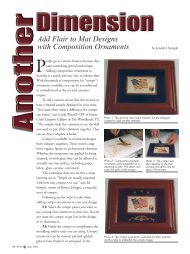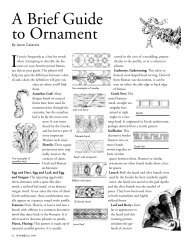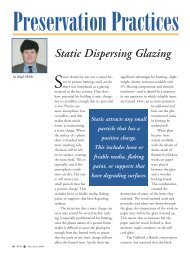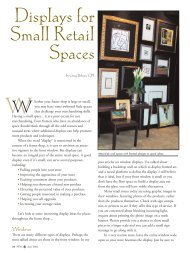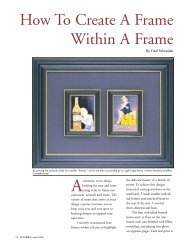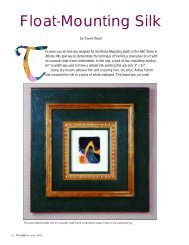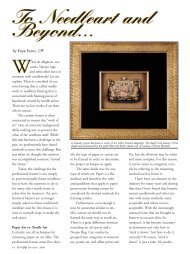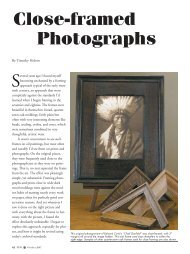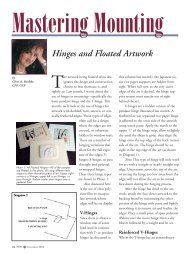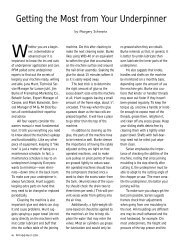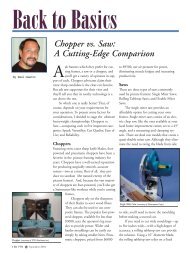TABLE OF CONTENTS - Picture Framing Magazine
TABLE OF CONTENTS - Picture Framing Magazine
TABLE OF CONTENTS - Picture Framing Magazine
Create successful ePaper yourself
Turn your PDF publications into a flip-book with our unique Google optimized e-Paper software.
URE 20].<br />
It may not be possible to achieve<br />
this if the sides of the frame are thin, and<br />
so another design can be used to<br />
enhance the carrying power of the frame.<br />
This strategy employs two loops of wire<br />
in place of the single strand or group of<br />
strands which usually run between the<br />
hangers. These two loops can be secured<br />
to two “D” ring or strap type hangers<br />
which are set vertically on the sides of<br />
the frame[FIGURE 21]. The complication<br />
comes when the frame is hung on<br />
the wall, since two hanging hooks must<br />
be set at the proper height on the wall.<br />
This is not as problematical as the hanging<br />
bar but should also be done by experienced<br />
personnel to avoid excessive<br />
damage to the wall from trial and error.<br />
Even the best design will not succeed<br />
if the wire itself breaks. Aluminum<br />
oxidizes in a less dramatic fashion than<br />
Figure 20<br />
i ro n<br />
or steel,<br />
but it will oxidize<br />
and ultimately<br />
break. The bright, shiny<br />
look of the fresh aluminum<br />
gives way to a dull gray and later a<br />
dark gray which indicates the extent of<br />
the oxidation. Copper wire is commonly<br />
used in museums for hanging pictures,<br />
but is so costly and difficult to handle<br />
that it is not often found in commercial<br />
framing. It too, can oxidize, but since it<br />
is a solid strand it has less surface<br />
exposed to the air. Coated and stainless<br />
steel wires are readily available to<br />
framers and should give much more<br />
dependable long term support where<br />
their increased expense and difficulty of<br />
handling can be warranted.<br />
One practice which should be<br />
avoided is the use of wire ru n n i n g<br />
through hanging devices of the bottom of<br />
the frame to try to distribute the weight<br />
m o re completely. This is sometimes<br />
done through the creation of one large<br />
loop of wire which runs through screw<br />
eyes on the sides of the frame and one or<br />
more on the bottom, usually set at or<br />
near the center. As the wire is pulled<br />
down by the weight of the frame, it will<br />
pull up on the bottom of the frame and<br />
may cause it to pull out of plane. This<br />
may mean that the glazing will be resting<br />
on one spot or point and in the case of<br />
glass can lead to breakage. It can also<br />
cause deformation of the edge of the mat<br />
package which will cause it to warp.<br />
Sectional frames have numero u s<br />
types of hangers which can be slipped or<br />
screwed into their hardware channels.<br />
Those which use a screw can be expect-<br />
ed to hold more securely over time and<br />
should hold more weight. If one of the<br />
deeper styles of frame is used to house a<br />
large work of art, the pull which wire<br />
may place on the hangers may be strong<br />
enough to begin to twist the moulding. In<br />
this case, the properly positioned strainer<br />
will solve this problem since the<br />
hanging hardware can now be set in the<br />
strainer and the weight more fully distributed.<br />
BA C K I N G PA P E R, DU S T CO V E R S,<br />
AND BUMPERS<br />
Contemporary frames which have strain-<br />
Figure 21



